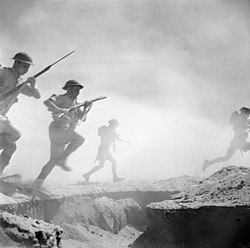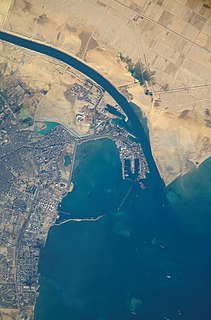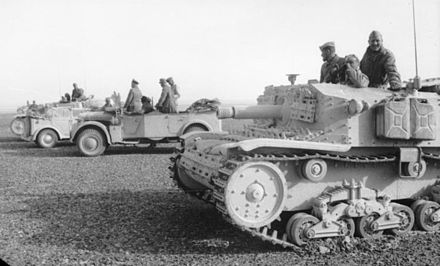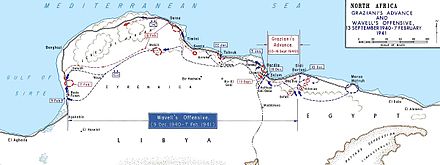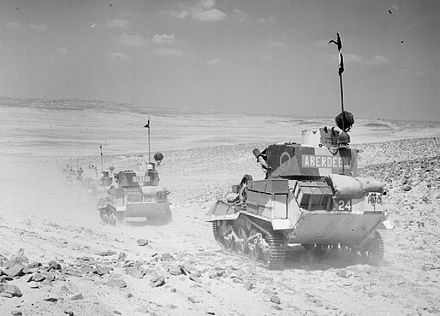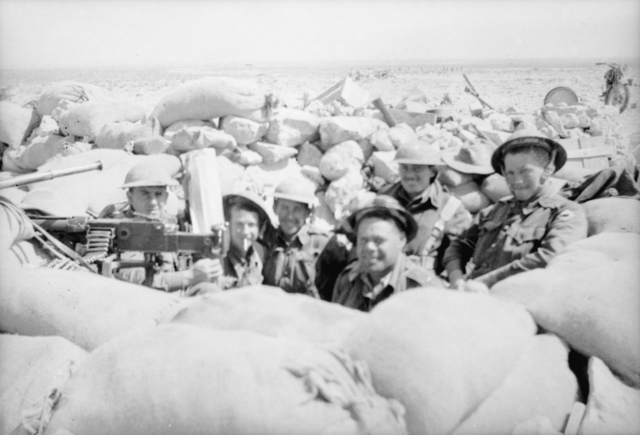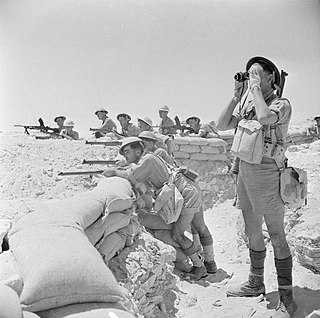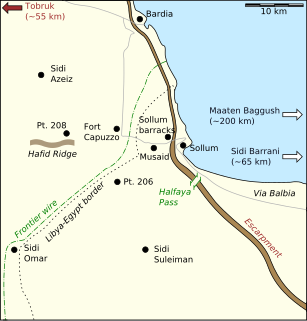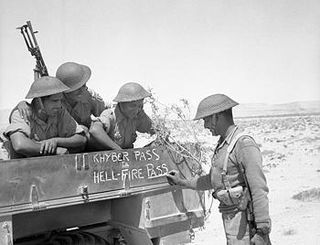It has been requested that the title of this article be changed to Western Desert campaign . Please see the relevant discussion on the discussion page. The page should not be moved unless the discussion is closed; summarizing the consensus achieved in support of the move. |
The Western Desert Campaign (Desert War), took place in the deserts of Egypt and Libya and was the main theatre in the North African Campaign during the Second World War. The campaign began in September 1940 with the Italian invasion of Egypt; Operation Compass, a British five-day raid in December 1940, led to the destruction of the Italian 10th Army. Benito Mussolini sought help from Adolf Hitler, who responded with a small German force sent to Tripoli under Directive 22 (11 January). The German Afrika Korps ( Generalleutnant Erwin Rommel) was under nominal Italian command but Italian dependency on Nazi Germany made it the dominant partner.

Egypt, officially the Arab Republic of Egypt, is a country spanning the northeast corner of Africa and southwest corner of Asia by a land bridge formed by the Sinai Peninsula. Egypt is a Mediterranean country bordered by the Gaza Strip and Israel to the northeast, the Gulf of Aqaba and the Red Sea to the east, Sudan to the south, and Libya to the west. Across the Gulf of Aqaba lies Jordan, across the Red Sea lies Saudi Arabia, and across the Mediterranean lie Greece, Turkey and Cyprus, although none share a land border with Egypt.

Libya, officially the State of Libya, is a country in the Maghreb region in North Africa, bordered by the Mediterranean Sea to the north, Egypt to the east, Sudan to the southeast, Chad to the south, Niger to the southwest, Algeria to the west, and Tunisia to the northwest. The sovereign state is made of three historical regions: Tripolitania, Fezzan and Cyrenaica. With an area of almost 1.8 million square kilometres (700,000 sq mi), Libya is the fourth largest country in Africa, and is the 16th largest country in the world. Libya has the 10th-largest proven oil reserves of any country in the world. The largest city and capital, Tripoli, is located in western Libya and contains over one million of Libya's six million people. The second-largest city is Benghazi, which is located in eastern Libya.

In warfare, a theater or theatre is an area in which important military events occur or are progressing. A theater can include the entirety of the airspace, land and sea area that is or that may potentially become involved in war operations.
Contents
- Background
- Libya
- Egypt
- Prelude
- Terrain
- Supply
- 1940
- Frontier skirmishes
- Operazione E
- Operation Compass
- 1941
- Greece
- Unternehmen Sonnenblume
- Siege of Tobruk
- 1942
- Unternehmen Theseus
- Battle of Gazala
- First Battle of El Alamein
- Battle of Alam el Halfa
- Second Battle of El Alamein
- Battle of El Agheila
- 1943
- Buerat
- Tripoli
- Aftermath
- Analysis
- See also
- Notes
- Footnotes
- Bibliography
- Books
- Journals
- Reports
- Theses
- Websites
- Further reading
- Books 2
- Reports 2
- Theses 2
- External links
In the spring of 1941, Axis forces under Rommel pushed the British back to Egypt except for the port of Tobruk, where the Siege of Tobruk took place until Operation Crusader. The Axis forces retired to where they had started by the end of the year. In 1942 Axis forces drove the British back again and captured Tobruk after the Battle of Gazala but failed to gain a decisive victory. On the final Axis push to Egypt, the British retreated to El Alamein, where at the Second Battle of El Alamein the Eighth Army defeated the Axis forces. They were driven out of Libya to Tunisia, where they were defeated in the Tunisian Campaign.

The Axis powers, also known as "Rome–Berlin–Tokyo Axis", were the nations that fought in World War II against the Allies. The Axis powers agreed on their opposition to the Allies, but did not completely coordinate their activity.

Tobruk or Tobruck is a port city on Libya's eastern Mediterranean coast, near the border with Egypt. It is the capital of the Butnan District and has a population of 120,000.
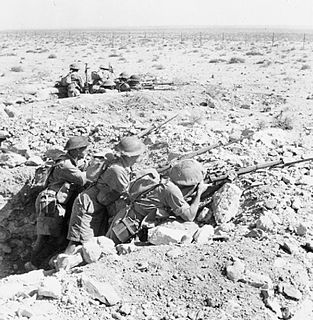
The Siege of Tobruk lasted for 241 days in 1941, after Axis forces advanced through Cyrenaica from El Agheila in Operation Sonnenblume against Allied forces in Libya, during the Western Desert Campaign (1940–1943) of the Second World War. In late 1940, the Allies had defeated the Italian 10th Army during Operation Compass (9 December 1940 – 9 February 1941) and trapped the remnants at Beda Fomm. During early 1941, much of the Western Desert Force (WDF) was sent to the Greek and Syrian campaigns. As German troops and Italian reinforcements reached Libya, only a skeleton Allied force remained, short of equipment and supplies.
The war in the desert became a sideshow for Germany once the war against the Soviet Union began on 22 June 1941. Italy and Germany never had sufficient resources or the means to deliver them to defeat the British, whose conquest of Libya was delayed by the diversion forces to Greece and the Levant in 1941 and the Far East in 1942.

The Soviet Union, officially the Union of Soviet Socialist Republics (USSR), was a socialist state in Eurasia that existed from 1922 to 1991. Nominally a union of multiple national Soviet republics, its government and economy were highly centralized. The country was a one-party state, governed by the Communist Party with Moscow as its capital in its largest republic, the Russian Soviet Federative Socialist Republic. Other major urban centres were Leningrad, Kiev, Minsk, Alma-Ata, and Novosibirsk. It spanned over 10,000 kilometres east to west across 11 time zones, and over 7,200 kilometres north to south. It had five climate zones: tundra, taiga, steppes, desert and mountains.

The Battle of Greece is the common name for the invasion of Allied Greece by Fascist Italy and Nazi Germany in April 1941 during World War II. The Italian invasion in October 1940, which is usually known as the Greco-Italian War, was followed by the German invasion in April 1941. German landings on the island of Crete came after Allied forces had been defeated in mainland Greece. These battles were part of the greater Balkan Campaign of Germany.

The Levant is an approximate historical geographical term referring to a large area in the Eastern Mediterranean, primarily in Western Asia. In its narrowest sense, it is equivalent to the historical region of Syria. In its widest historical sense, the Levant included all of the eastern Mediterranean with its islands; that is, it included all of the countries along the Eastern Mediterranean shores, extending from Greece to Cyrenaica.
